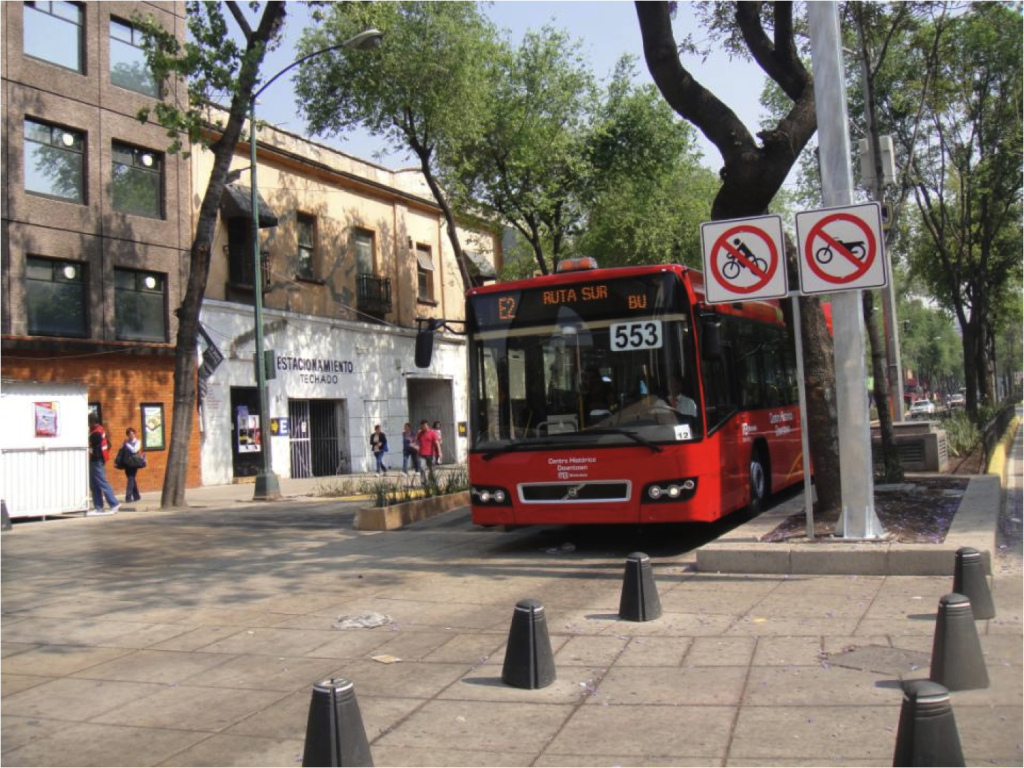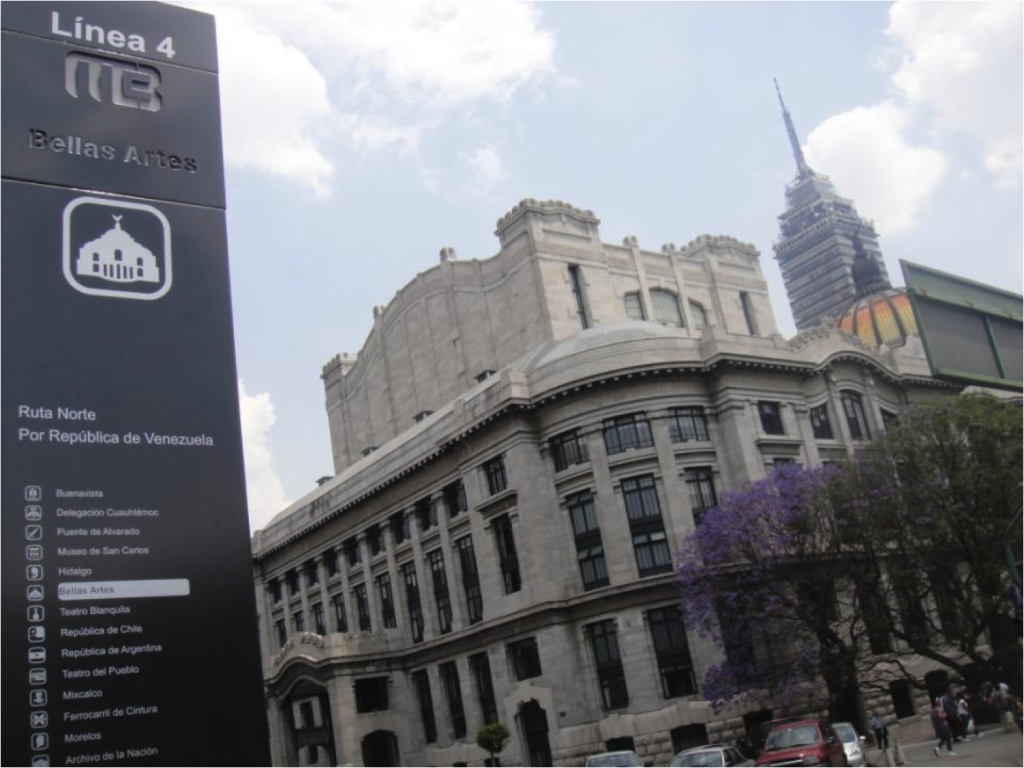Source: The City Fix by Dario Hidalgo*

Downtown streets in Mexico City’s Historic District were totally rebuilt to provide safe transit for the new buses and help recover the urban environment. Photo by EMBARQ Mexico.
Mexico City now has a new bus service running through the heart of the Historic District, with service to the international airport. Metrobus Line 4, which opened on April 1, shows ingenuity and exemplifies the core characteristic of bus-based transit systems: being flexible.
When the city started planning for the corridor criss-crossing through downtown, EMBARQ Mexico helped them in two ways: suggesting adequate designs for narrow streets and considering pedestrian safety as a top concern. The technical team provided information about narrow corridors in the historic centers of Quito and Guayaquil, Ecuador, and Bogota, Colombia, where bus rapid transit (BRT) had already been implemented. When the designs were advanced, EMBARQ conducted a road safety audit, reviewing the designs and locations of the planned BRT corridor and making recommendations on how to make the transport systems safer for users. The audit was led by consultant Carsten Waas and EMBARQ Transportation Research Analyst Nicolae Duduta. Many of the recommendations were adopted, thereby improving several intersections. During the implementation phase, EMBARQ Mexico also provided designs for signage.
The circular line uses low-floor, 12-meter buses, an innovation from the high-floor, articulated 18-meter buses used in Lines 1, 2 and 3. Its air conditioned fleet of 46 Diesel Euro V buses and eight hybrid buses are considered to be the most advanced in the region. Fare collection is on board, for a change, using smart cards and integrated with the rest of the bus and metro network. The addition of air conditioning, advanced engines and on-board ticketing shows that it is always possible to innovate and stay ahead with technology.
But the nicest part of the system is not the buses. It is the immense care in designing bus infrastructure in a challenging environment. Downtown Mexico City is a jewel of colonial architecture, with narrow streets and beautiful buildings. It also has some areas that have deteriorated over the years. The implementation of the new bus line helped recover some of the most dreadful streets in the Historic District, with wall-to-wall interventions, adapting its design to changing conditions along the route.

A totem at Bellas Artes Station, showing three Mexico City icons together: the Fine Arts Theater, the Latin American Tower, and Metrobus. Photo by EMBARQ Mexico.
Metrobus joins Quito and Guayaquil, Ecuador; and Pereira and Bogota, Colombia, in using downtown narrow streets exclusively for buses and pedestrians—not an easy task due to the worries of local merchants and parking operators. The design also needed to pass the tough requirements of the Historic Center Authority, which has been working over decades to recover the heart of Mexico City.
One interesting feature of the new line is the extended service to the international airport, providing passengers and workers access to an attractive and cheaper alternative to connect. It is amazing to see the buses “flying” through the dedicated bus lanes to the airport, while the cars and taxis are stuck in the gridlock of Mexico City, which has been ranked worst for car-commuter “pain” in the latest survey by IBM that ranks 20 world cities for the best and worst commutes.
REMARKABLE HISTORY
With the launch of Metrobus in 2005, Mexico showed, against all odds, that it was possible to dedicate lanes to buses on the longest avenue in Latin America, Avenida Insurgentes. In just a few short years, it grew its bus system from 20 kilometers in 2005 to 95 kilometers in 2012. Now it shows us that BRT concepts are flexible enough to cater to the challenging environment of the Historic District in the third largest megacity in the world. The new addition of Line 4 places Mexico City ahead of other cities in Latin America when it comes to the total length of bus corridors, exceeding the 84-kilometer system of Bogota and the 75-kilometer system of Curitiba—a city known for being the birthplace of BRT.
Mexico’s mass transit systems combined now boast 309 kilometers and cater to 5.8 million passengers every day. In Mexico City, alone, there are 214 kilometers of metro and light rail lines, built between 1968 and 2000. In addition, the neighboring State of Mexico has two BRT corridors (Mexibus), and there is a 27-kilometer suburban rail line, which opened in 2008.

Line 4 operates in a challenging environment of narrow historic streets. Photo by EMBARQ Mexico.
CHALLENGES AHEAD
The toughest challenge of Metrobus Line 4 was to implement bus services in a 10-meter wide right-of-way, including the sidewalks. Another challenge was dealing with the high pedestrian activity in this commercial, institutional, cultural and touristic hub. The design is full of elements to protect and provide clear guidance to pedestrians, but there is still a lot to improve, especially since jaywalking is a way of life in this part of the city.
Other features that need improvement are the programming of traffic lights and communications to potential users. Since the corridor does not have traffic signal priority, passengers are losing a lot of time at intersections. On the other hand, many potential users are not aware of the new service, including those arriving on the suburban rail line at Buenavista at the western edge of downtown.
EMBARQ Mexico, under the leadership of transport systems expert Marco Priego and other members of the technical team, provided continued support to the local government in the design and implementation of the new line. This was critical for the initial approval of the project, as there was skepticism about the possibility of running a BRT on such narrow streets. Several design elements in the stations, including the iconography of signage, were the result of EMBARQ Mexico’s recommendations. EMBARQ also provided a road safety audit, and about half of the recommendations were included in the final design.
Now that the system is in operation, EMBARQ Mexico has provided a review, highlighting additional aspects of the system to improve. Road safety, especially, can be enhanced through design, driver training and user education.
Congratulations to Mexico on this new achievement!
*With input from Marco Priego.
¿Comments? ¿Opinions? ¿Similar News? Send them to us!












